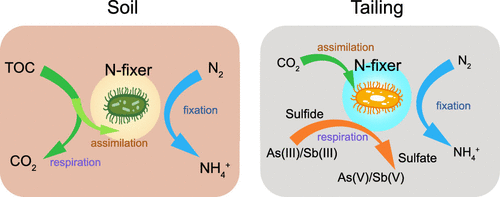当前位置:
X-MOL 学术
›
Environ. Sci. Technol.
›
论文详情
Our official English website, www.x-mol.net, welcomes your feedback! (Note: you will need to create a separate account there.)
Chemolithoautotropic Diazotrophy Dominates the Nitrogen Fixation Process in Mine Tailings.
Environmental Science & Technology ( IF 11.4 ) Pub Date : 2020-04-05 , DOI: 10.1021/acs.est.9b07835 Xiaoxu Sun 1, 2, 3 , Tianle Kong 1, 4 , Max M Häggblom 5 , Max Kolton 1 , Fangbai Li 1, 2, 3 , Yiran Dong 6 , Yuqing Huang 1 , Baoqin Li 1 , Weimin Sun 1, 2, 3
Environmental Science & Technology ( IF 11.4 ) Pub Date : 2020-04-05 , DOI: 10.1021/acs.est.9b07835 Xiaoxu Sun 1, 2, 3 , Tianle Kong 1, 4 , Max M Häggblom 5 , Max Kolton 1 , Fangbai Li 1, 2, 3 , Yiran Dong 6 , Yuqing Huang 1 , Baoqin Li 1 , Weimin Sun 1, 2, 3
Affiliation

|
Nutrient deficiency, especially bio-available nitrogen deficiency, often impedes the bioremediation efforts of mining generated tailings. Biological nitrogen fixation is a critical process necessary for the initial nitrogen buildup in tailings. Current knowledge regarding the diazotrophs that inhabit tailings is still in its infancy. Therefore, in this study, a comprehensive investigation combining geochemical characterization, sequence analyses, molecular techniques, and activity measurements was conducted to characterize the diazotrophic community residing in tailing environments. Significant differences between tailings and their adjacent soils in prokaryotic and diazotrophic communities were detected. Meanwhile, strong and significant correlations between the absolute abundance of the nitrogen fixation (nifH), carbon fixation (cbbL), sulfur oxidation (soxB), and arsenite oxidation (aioA) genes were observed in the tailings but not in the soils. The reconstructed nif-containing metagenome-assembled genomes (MAGs) suggest that the carbon fixation and sulfur oxidation pathways were important for potential diazotrophs inhabiting the tailings. Activity measurements further confirmed that diazotrophs inhabiting tailings preferentially use inorganic electron donors (e.g., elemental sulfur) compared to organic electron donors (e.g., sucrose), while diazotrophs inhabiting soils preferred organic carbon sources. Collectively, these findings suggest that chemolithoautotrophic diazotrophs may play essential roles in acquiring nutrients and facilitating ecological succession in tailings.
中文翻译:

变质自渗重氮在矿山尾矿的固氮过程中起主导作用。
营养缺乏,特别是生物可利用的氮缺乏,通常会阻碍采矿产生的尾矿的生物修复工作。生物固氮是尾矿中初始氮积累所必需的关键过程。有关居住在尾矿中的重氮营养菌的最新知识仍处于起步阶段。因此,在这项研究中,进行了一项综合研究,结合了地球化学特征,序列分析,分子技术和活性测量,以表征居住在尾矿环境中的重氮营养群落。在原核和重氮营养群落中,尾矿及其邻近土壤之间存在显着差异。同时,固氮的绝对丰度(nifH),固碳的绝对丰度(cbbL),在尾矿中观察到硫氧化(soxB)和亚砷酸盐氧化(aioA)基因,但在土壤中未观察到。重建的含nif的元基因组组装基因组(MAGs)表明,碳固定和硫氧化途径对于居住在尾矿中的潜在重氮营养菌很重要。活性测量结果进一步证实,与有机电子给体(例如蔗糖)相比,居住在尾矿中的重氮营养菌优先使用无机电子给体(例如,元素硫),而居住在土壤中的重氮营养菌则首选有机碳源。总的来说,这些发现表明,化石自养重氮菌在获取养分和促进尾矿的生态演替中可能起重要作用。重建的含nif的元基因组组装基因组(MAGs)表明,碳固定和硫氧化途径对于居住在尾矿中的潜在重氮营养菌很重要。活性测量结果进一步证实,与有机电子给体(例如蔗糖)相比,居住在尾矿中的重氮营养菌优先使用无机电子给体(例如,元素硫),而居住在土壤中的重氮营养菌则首选有机碳源。总体而言,这些发现表明,化石自养重氮菌可能在获取养分和促进尾矿的生态演替中起重要作用。重建的含nif的元基因组组装基因组(MAGs)表明,碳固定和硫氧化途径对于居住在尾矿中的潜在重氮营养菌很重要。活性测量结果进一步证实,与有机电子给体(例如蔗糖)相比,居住在尾矿中的重氮营养菌优先使用无机电子给体(例如,元素硫),而居住在土壤中的重氮营养菌则首选有机碳源。总体而言,这些发现表明,化石自养重氮菌可能在获取养分和促进尾矿的生态演替中起重要作用。活性测量结果进一步证实,与有机电子给体(例如蔗糖)相比,居住在尾矿中的重氮营养菌优先使用无机电子给体(例如,元素硫),而居住在土壤中的重氮营养菌则首选有机碳源。总的来说,这些发现表明,化石自养重氮菌在获取养分和促进尾矿的生态演替中可能起重要作用。活性测量结果进一步证实,与有机电子给体(例如蔗糖)相比,居住在尾矿中的重氮营养菌优先使用无机电子给体(例如,元素硫),而居住在土壤中的重氮营养菌则首选有机碳源。总的来说,这些发现表明,化石自养重氮菌在获取养分和促进尾矿的生态演替中可能起重要作用。
更新日期:2020-03-27
中文翻译:

变质自渗重氮在矿山尾矿的固氮过程中起主导作用。
营养缺乏,特别是生物可利用的氮缺乏,通常会阻碍采矿产生的尾矿的生物修复工作。生物固氮是尾矿中初始氮积累所必需的关键过程。有关居住在尾矿中的重氮营养菌的最新知识仍处于起步阶段。因此,在这项研究中,进行了一项综合研究,结合了地球化学特征,序列分析,分子技术和活性测量,以表征居住在尾矿环境中的重氮营养群落。在原核和重氮营养群落中,尾矿及其邻近土壤之间存在显着差异。同时,固氮的绝对丰度(nifH),固碳的绝对丰度(cbbL),在尾矿中观察到硫氧化(soxB)和亚砷酸盐氧化(aioA)基因,但在土壤中未观察到。重建的含nif的元基因组组装基因组(MAGs)表明,碳固定和硫氧化途径对于居住在尾矿中的潜在重氮营养菌很重要。活性测量结果进一步证实,与有机电子给体(例如蔗糖)相比,居住在尾矿中的重氮营养菌优先使用无机电子给体(例如,元素硫),而居住在土壤中的重氮营养菌则首选有机碳源。总的来说,这些发现表明,化石自养重氮菌在获取养分和促进尾矿的生态演替中可能起重要作用。重建的含nif的元基因组组装基因组(MAGs)表明,碳固定和硫氧化途径对于居住在尾矿中的潜在重氮营养菌很重要。活性测量结果进一步证实,与有机电子给体(例如蔗糖)相比,居住在尾矿中的重氮营养菌优先使用无机电子给体(例如,元素硫),而居住在土壤中的重氮营养菌则首选有机碳源。总体而言,这些发现表明,化石自养重氮菌可能在获取养分和促进尾矿的生态演替中起重要作用。重建的含nif的元基因组组装基因组(MAGs)表明,碳固定和硫氧化途径对于居住在尾矿中的潜在重氮营养菌很重要。活性测量结果进一步证实,与有机电子给体(例如蔗糖)相比,居住在尾矿中的重氮营养菌优先使用无机电子给体(例如,元素硫),而居住在土壤中的重氮营养菌则首选有机碳源。总体而言,这些发现表明,化石自养重氮菌可能在获取养分和促进尾矿的生态演替中起重要作用。活性测量结果进一步证实,与有机电子给体(例如蔗糖)相比,居住在尾矿中的重氮营养菌优先使用无机电子给体(例如,元素硫),而居住在土壤中的重氮营养菌则首选有机碳源。总的来说,这些发现表明,化石自养重氮菌在获取养分和促进尾矿的生态演替中可能起重要作用。活性测量结果进一步证实,与有机电子给体(例如蔗糖)相比,居住在尾矿中的重氮营养菌优先使用无机电子给体(例如,元素硫),而居住在土壤中的重氮营养菌则首选有机碳源。总的来说,这些发现表明,化石自养重氮菌在获取养分和促进尾矿的生态演替中可能起重要作用。


























 京公网安备 11010802027423号
京公网安备 11010802027423号